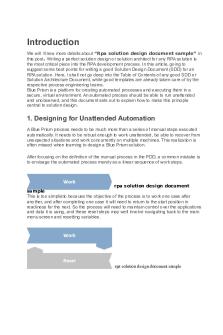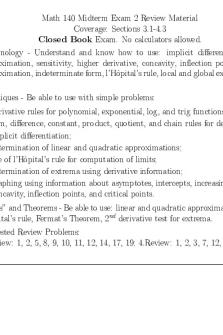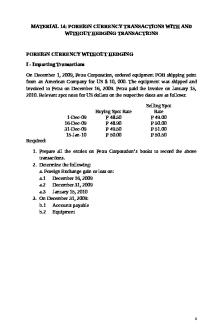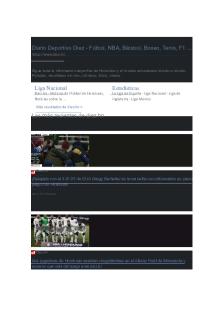2 - Material PDF

| Title | 2 - Material |
|---|---|
| Author | NN NK |
| Course | Machine Learning |
| Institution | University of Nottingham |
| Pages | 5 |
| File Size | 345.4 KB |
| File Type | |
| Total Downloads | 106 |
| Total Views | 173 |
Summary
Material...
Description
Introduction We will Know more details about “Rpa solution design document sample” in this post. Writing a perfect solution design or solution architect for any RPA solution is the most critical piece into the RPA development process. In this article, going to suggest some best points for writing a good Solution Design Document (SDD) for an RPA solution. Here, I shall not go deep into the Table of Contents of any good SDD or Solution Architecture Document, while good templates are already taken care of by the respective process engineering teams. Blue Prism is a platform for creating automated processes and executing them in a secure, virtual environment. An automated process should be able to run unattended and unobserved, and this document sets out to explain how to make this principle central to solution design.
1. Designing for Unattended Automation A Blue Prism process needs to be much more than a series of manual steps executed automatically. It needs to be robust enough to work unattended, be able to recover from unexpected situations and work concurrently on multiple machines. This realization is often missed when learning to design a Blue Prism solution. After focusing on the definition of the manual process in the PDD, a common mistake is to envisage the automated process merely as a linear sequence of work steps.
rpa solution design document sample This is too simplistic because the objective of the process is to work one case after another, and after completing one case it will need to return to the start position in readiness for the next. So the process will need to maintain control over the applications and data it is using, and these reset steps may well involve navigating back to the main menu screen and resetting variables.
rpa solution design document sample
At some point, the process will also need to break out of this loop, and often this is simply when there are no more cases left to work but the decision could also be made for other reasons, such as when the end of the working day is reached.
Solution design document Example : It is also likely that there will be additional steps before and after the working loop. Examples of preparation steps are things like logging in to applications and gathering input data. The finishing steps could be something like logging out and closing down the applications, creating a report or sending an email notification.
rpa solution design document sample To illustrate this consider the following process constructed using the Blue Prism Basic Template. The three areas outside of case processing (work) are clearly marked.
Another common oversight when designing a process is to assume that it will never encounter any problems and always stay on the ‘happy path’. Again, this is unrealistic and recovery steps should be included to cater for the ‘unhappy path’ logic, as shown below in orange.
rpa solution design document sample Here exception handing is employed to make the process recover from unexpected application behavior, so that cases can be set aside for manual investigation or if necessary, reworked by the process. The recovery logic may also need the ability to restart applications for the process to continue working.
Solution Types There are different types of an automated solution that can be applied to a manual process. Consider this abstract process, comprised of manual steps 1 to 9
rpa solution design document sample Full Automation: The ideal scenario is when all manual steps can be automated and that the entire manual process can be replaced. Note that for simplicity the effort in manually resolving exception cases has not been illustrated here.
rpa solution design document sample Partial Automation: If complete automation cannot be achieved, then it may be possible to automate a sequence of contiguous steps within the original manual process. Ideally, the effort in the remaining manual steps would be offset by the savings brought by the automated steps. Often in this kind of partial automation, an adjustment to the remaining manual steps is required to enable the automation. For example, in step M1 the user may need to prepare structured data for step A2 to consume. Similarly, in step M9 the user may need to become the recipient of a handoff from A8.
Fragmented Partial Automation :
rpa solution design document sample If continuous automation cannot be achieved, then maybe automation can be applied to more than one sequence of steps. Here the links between the manual and automated steps need t...
Similar Free PDFs

2 - Material
- 5 Pages

Exam 2 Material
- 23 Pages

Exam 2 Material
- 23 Pages

Biochemistry Exam 2 Material
- 38 Pages

Blaw exam 2 material
- 15 Pages

2. Juegos sin material corregido
- 12 Pages

PSYC 430- Exam material 2
- 10 Pages

Biochem exam 2 - exam 2 material
- 7 Pages

Midterm 2 review material guide
- 6 Pages

Material para la Práctica 2
- 12 Pages

MATERIAL-
- 23 Pages
Popular Institutions
- Tinajero National High School - Annex
- Politeknik Caltex Riau
- Yokohama City University
- SGT University
- University of Al-Qadisiyah
- Divine Word College of Vigan
- Techniek College Rotterdam
- Universidade de Santiago
- Universiti Teknologi MARA Cawangan Johor Kampus Pasir Gudang
- Poltekkes Kemenkes Yogyakarta
- Baguio City National High School
- Colegio san marcos
- preparatoria uno
- Centro de Bachillerato Tecnológico Industrial y de Servicios No. 107
- Dalian Maritime University
- Quang Trung Secondary School
- Colegio Tecnológico en Informática
- Corporación Regional de Educación Superior
- Grupo CEDVA
- Dar Al Uloom University
- Centro de Estudios Preuniversitarios de la Universidad Nacional de Ingeniería
- 上智大学
- Aakash International School, Nuna Majara
- San Felipe Neri Catholic School
- Kang Chiao International School - New Taipei City
- Misamis Occidental National High School
- Institución Educativa Escuela Normal Juan Ladrilleros
- Kolehiyo ng Pantukan
- Batanes State College
- Instituto Continental
- Sekolah Menengah Kejuruan Kesehatan Kaltara (Tarakan)
- Colegio de La Inmaculada Concepcion - Cebu




